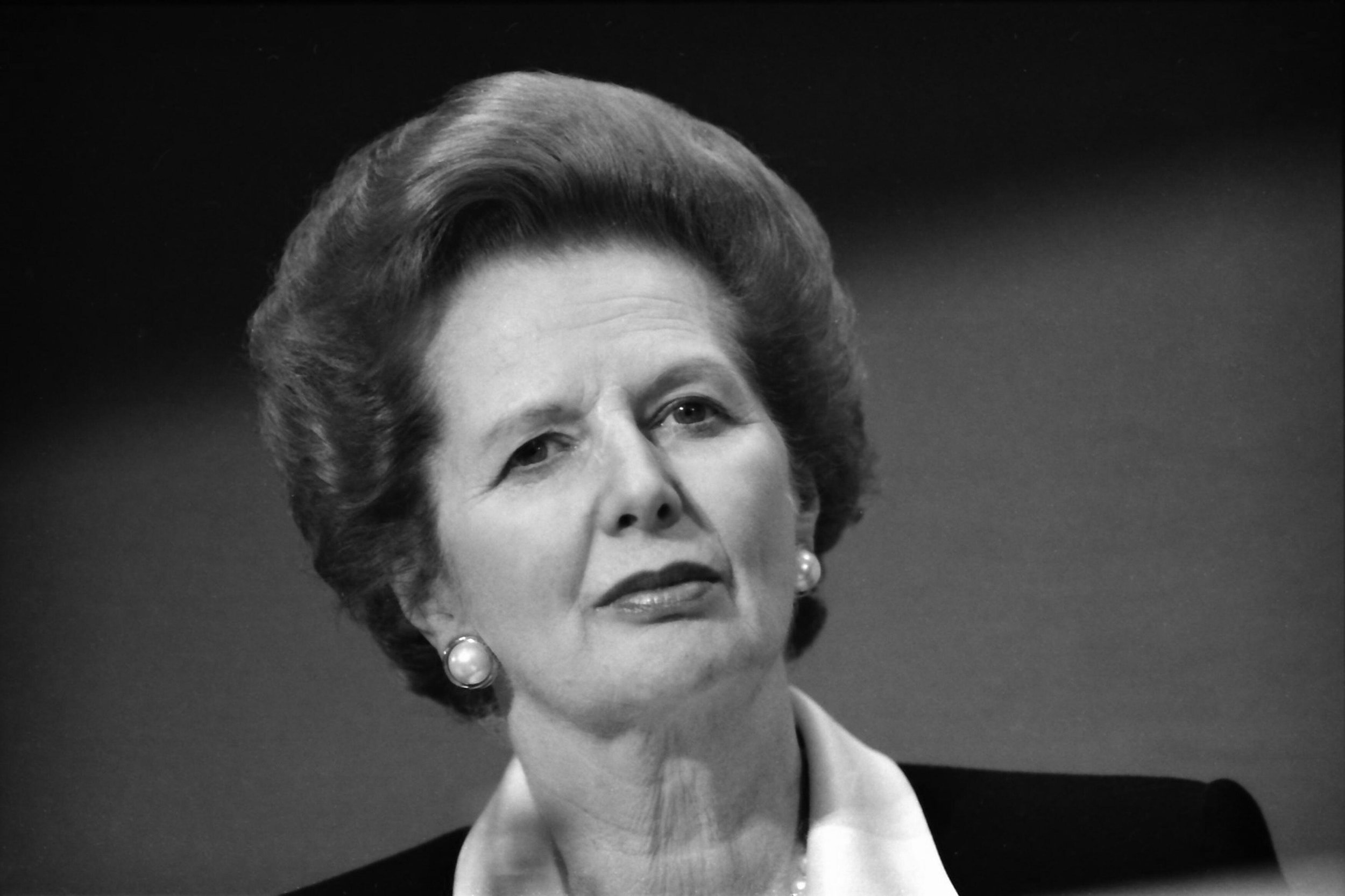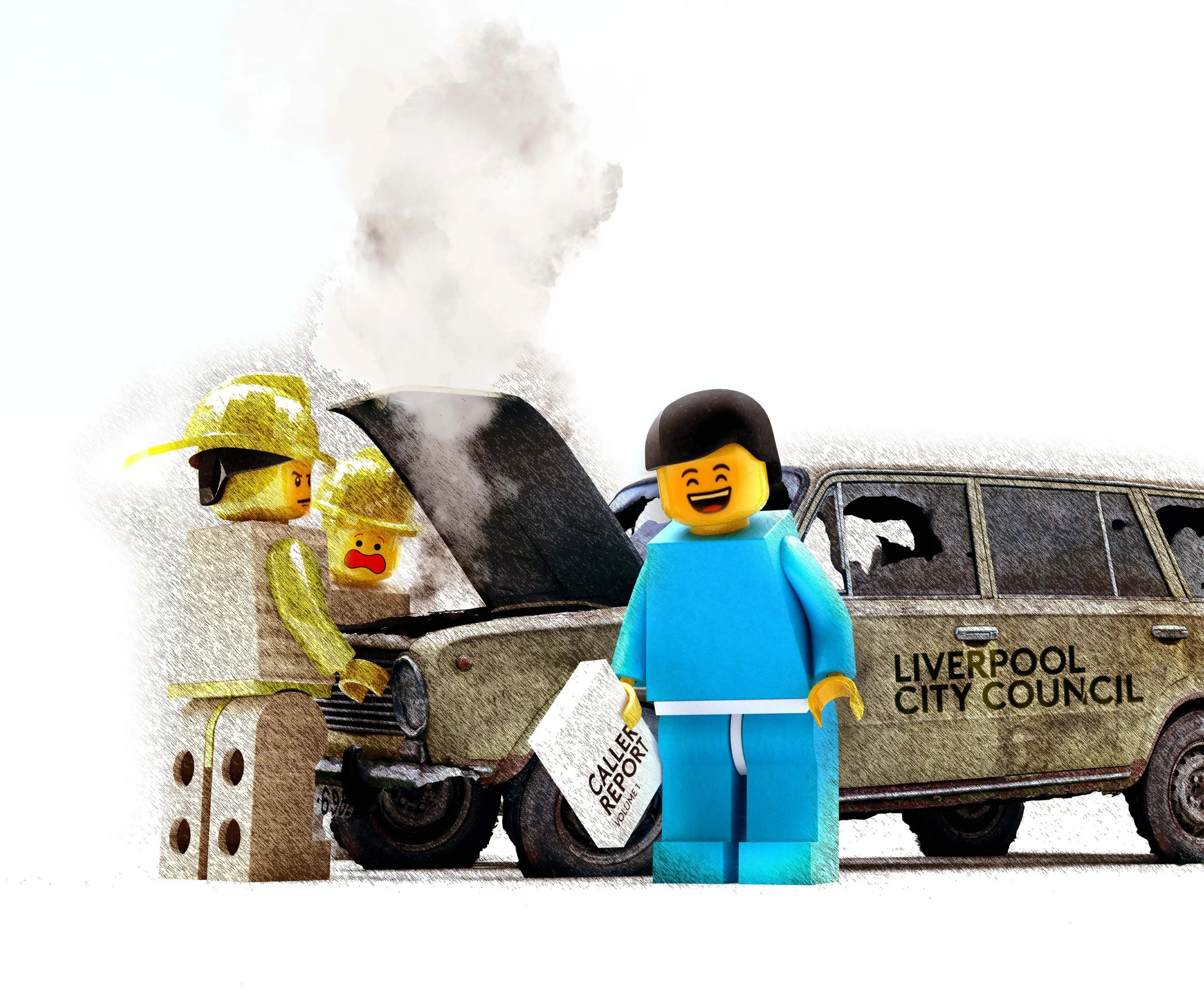Recent features
Mancpool: One Mayor, One Authority, One Vision?
Should the city of Liverpool throw in its lot with Manchester and accept one combined North West Metro Mayor to rule us all? Despite admitting that such a suggestion is about as saleable as a One State Solution for Israel-Palestine, Jon Egan thinks it’s an idea whose time has come. It’s certainly an idea that’s provoked some debate within Liverpolitan Towers. But what do you think?
Jon Egan
Manchester Bees Meet Liverpool Super Lambananas by mmcd studio
Is it time the city of Liverpool threw its lot in with Manchester and accepted one combined North West Metro Mayor to rule us all? Jon Egan thinks so. As you can imagine, the suggestion has caused some debate in Liverpolitan Towers and we are not all in agreement. But what do you think? Here Jon makes his case and hints at future initiatives to come…
So let me issue a warning now. This article contains material that many Liverpudlians will find deeply distressing and offensive. It’s an argument that I have tentatively proffered in the past, but after profound and serious reflection, have concluded, now needs to be set out in the most explicit and uncompromising of terms. You have been warned.
David Lloyd’s recent article for The Post lamenting the exodus of Liverpool’s “best and brightest” was as ever an enlightening and enjoyable read, notwithstanding its downbeat and dispiriting narrative of civic and economic decline. If I can add a generational postscript in support of David’s thesis, every member of our youngest daughter’s friendship group from Bluecoat School now lives and works outside Liverpool.
It was the nineteenth century philosopher, Friedrich Nietzche who argued that only as an “aesthetic phenomenon” does the tragedy of human existence find its eternal justification, and perhaps it’s only in the exquisite prose and imaginative virtuosity of David’s writing that Liverpool’s own tragic predicament becomes philosophically palatable. I admire David’s resolute determination to find some tiny component of hope, offered in the city’s joyously ephemeral hosting of Eurovision 2023. But does our capacity for celebration, hospitality and togetherness provide the alchemy for a viable economic renaissance? Does it, at best, illuminate Liverpool’s status as a half-city, stripped of its economic and productive assets, now reduced to the sheer potentiality of its human capital?
The idea of Liverpool as a stage set for cultural spectacles and entertainment extravaganzas (hyperbolically described by the city’s cultural supremo, Claire McColgan as “moments of absolute global significance”), is a beguiling substitute for an actual economy, and an ability to offer a livelihood for the generations who continue to depart for more attractive and seemingly successful cities. It’s a vision that also reminds me of another of Italo Calvino’s magical realist parables in his masterpiece novel, Invisible Cities. Sophronia, the half-city of roller-coasters, carousels, Ferris wheels and big tops, where it is the banks, factories, ministries and docks that are dismantled, loaded onto trailers and taken away to their next travelling destination.
“I fully grasp the deeply heretical nature of this proposition. A ‘One State’ solution for the Liverpool and Manchester City Regions is about as saleable as a one state solution for Israel and Palestine.”
Two hundred years ago, the realisation that we were a half-city inspired Liverpool’s city fathers to contemplate a project that would have world-changing implications - a genuine moment of “absolute global significance”. Prior to the construction of the world’s first inter-city railway, every human journey between major population centres would be dependent on the locomotive capabilities of the horse. Railways were the harbingers of modernity, compressing time and space, and in this instance, connecting one of the world’s great trading centres with its greatest manufacturing hub. Umbilically conjoined, the two half-cities (the place that trades and the place that makes), became the nexus for Britain’s industrial and imperial prowess for the next hundred years.
If the railway brought Liverpool and Manchester closer together, recent decades have been dominated by a football-terrace inspired antagonism aimed at driving us further apart. Liverpool’s antipathy to our more affluent neighbour would seem also to betray more than a slight hint of jealousy, as our rival has greedily accumulated the trappings and status of regional capital.
Rather than resenting Manchester’s success or investing in a strategy of do-or-die competition, is there a smarter and mutually beneficial alternative? Is it time to re-imagine a more symbiotic relationship, that realises that for every British provincial city, the real competition is located 200 miles to the south?
Of course, this is not an original proposition. In the early noughties, Liverpool Leader, Mike Storey and his Manchester counterpart, Richard Leese signed their much lauded Joint Concordat - an agreement only marginally less shocking than the Molotov-Ribbentrop ‘Non-Aggression’ Pact of 1939 between Nazi Germany and the Soviet Union. The benefits were equally short lived. The agreement was conceived in the golden age of regionalism when under the aegis of John Prescott’s mega-ministry - the Department for the Environment, Transport and the Regions - levelling-up and rebalancing were not mere meaningless mantras but core political imperatives. For all its good works, the now defunct North West Development Agency, which once employed 500 people to drive the region’s growth, was more of a hindrance than an enabler for a serious rapprochement between the city’s two main economic players. Determined to uphold scrupulous neutrality between Liverpool and Manchester (it’s Warrington-base memorably described by broadcaster and musical impresario Tony Wilson as being located in the “perineum” of the North West), the agency was forged by a powerful Labour Lancashire mafia, with a brief to prevent and constrain the domineering tendencies of the two cities.
The ill-fated 2001 Joint Concordat between Liverpool and Manchester was only marginally more palatable than the Molotov-Ribbentrop Pact of 1939 which saw the carve up of Poland. Bundesarchiv, Bild 183-H27337 / CC-BY-SA 3.0
“The idea of Liverpool as a stage set for cultural spectacles and entertainment extravaganzas is a beguiling substitute for an actual economy.”
The Storey-Leese pact conceded Manchester’s status as regional capital, a painful admission of subservience that probably explains the reluctance of subsequent Liverpool leaders to pursue similar overtures. The Liverpool City Region and Greater Manchester devolution deals, and the election of “great mates” Steve Rotheram and Andy Burnham has seen little practical collaboration, beyond occasional media stunts and chummy get-togethers to compare their favourite home-grown pop tunes. Those who expected more than a Northern Variety Hall double act have thus far been disappointed by devolution projects intent on protecting sub-regional domains and denying the compelling reality of geographic and economic interdependence.
We’re two cities less than 30 miles apart, whose fuzzy edges and increasingly footloose populations are blind to civic boundaries that no longer delineate where or how people live, work and play. People are already beginning to see and experience the cities as a single urban place - we just need to dismantle some of the physical and administrative obstacles.
It is beyond farcical that train travel between the two city centres is only marginally quicker today than it was when Stephenson’s Rocket completed its maiden journey two centuries ago. At a pre-MIPIM real estate seminar a few years ago, a Liverpool property professional opined that the single biggest boost to Liverpool’s commercial office market would be a 20 minute train service to Manchester city centre. Who knows, it may even have been enough to persuade Liverpool-nurtured companies like the sports fashion-brand, Castore, to stay in a better connected city location instead of moving to our city neighbour (and taking 300 jobs with it). Questioning the benefits of a fully integrated single strategic transport authority to straddle the two city-regions, is equivalent to advocating the abolition of Transport for London and its replacement by two rival authorities with briefs never to talk to each other.
“Rather than resenting Manchester’s success or investing in a strategy of do-or-die competition, is there a smarter and mutually beneficial alternative?”
For those who ask what’s in it for Manchester, the answer is the well attested and quantifiable benefits of economic agglomeration - cost efficiencies, labour pooling, expanded markets, knowledge spill-overs… Whilst working for the think tank, ResPublica on a project to build the economic case for Liverpool’s connection to HS2, I was staggered to hear Manchester’s economic strategist Mike Emmerich admit that his city envied aspects of Liverpool’s asset-base. The hard and soft criteria by which urban theorists like Saskia Sassen measure the credentials of aspiring global cities, seem evenly dispersed between the twin cities of the Mersey Valley. We can’t match Manchester’s international transport connections, its media and knowledge clusters, but neither can they compete with Liverpool’s global brand, our cultural prowess, architectural grandeur and liveability offer.
If transport is the no-brainer, the wider benefits of agglomeration need to be systematically mapped and identified. The amorphous promise of a Northern Powerhouse can only be realised in physical space, and the contiguity of our two city regions make this the most viable location for a re-balancing project. If the North is ever to grow an economic counter-weight to London, then connecting the two closest jigsaw pieces together seems like a sensible undertaking. Whether its land-use planning or plotting economic development, investment and skills strategies, it’s nonsensical for the two city regions to be pursuing their respective goals in blissful oblivion of what is happening on the other side of an arbitrarily contrived line on a map.
Notwithstanding, its invaluable enabling role in gap funding development and infrastructure projects, the North West Development Agency was a political creation without underpinning logic or legitimacy. Were there ever any connecting threads of economic interest between Salford and Penrith? Wilmslow and Barrow-in-Furness? The Agency’s opaque governance, and its tortuous high-wire balancing act, placating a multiplicity of sub-regional agendas and interest groups, inhibited its ability to optimise the potential of the region’s two great economic engines.
So here comes the controversial bit. Pacts, concordats and convivial personal relationships are simply not sufficient to realise the potential of a new economic relationship between the two city regions - one that acknowledges that their respective asset-bases can be curated for mutual benefit. The only solution is a new governance structure - a devolution model with one Metro Mayor and one Combined Authority. I fully grasp the deeply heretical nature of this proposition, and the threat that it seems to pose to the identity and autonomy of a city that suspects it will be the junior player in any such arrangement. But are identities any more compromised in a ‘Twin City Region’ than they are within the current dispensation? St Helens, Sefton, Wirral, Wigan, Bolton amongst others would probably argue not. The integrity and jurisdiction of the respective city councils and other local authorities would not be compromised - we would only be pooling functions and responsibilities that are already acknowledged to be regional, and projecting them onto a bigger and less artificially contrived regional canvas.
“The only solution is a new governance structure - a devolution model with one Metro Mayor and one Combined Authority.”
Once upon a time, Liverpool and Manchester were authorities under the even more commodious administrative umbrella of Lancashire County Council, and as I‘ve mentioned, more recently, through the North West Development Agency, we were content to buy into the concept of a North West regional project conspicuously lacking any democratic accountability.
In a Twitter / X exchange with Liverpolitan a few weeks ago, I was asked to defend this joint governance proposition by pointing to a successful or established similar model elsewhere in the world. In the US, the twin cities of Minneapolis and St Paul, and of Dallas and Fort Worth, and the urban centres of the San Francisco Bay Area have come together in different ways to pool planning, transportation and economic development responsibilities. Closer to home, the Ruhr Regional Association in Germany exercises both a statutory and enabling role in areas including planning, infrastructure, economic development and environmental protection for the cities of Dortmund, Duisburg, Essen and Bochum. But even if there is no precise template elsewhere, should this be an inhibitor to the cities that built the world’s first inter-city railway, and that pioneered many of the most progressive advances in civic governance in the 19th and early 20th centuries?
In the absence of compelling practical arguments against the proposition, the most likely and persuasive objection will be that the mutual rivalry runs too deep, the antagonism is simply too intense and has festered too long. A ‘One State’ solution for the Liverpool and Manchester City Regions is about as saleable as a one state solution for Israel and Palestine. Maybe it’s an argument that requires a solution or a process rather than a rebuttal. In truth, antipathy is a quite recent addition to a history of rivalry that owes more than a little to the intensity of the competition between the country’s two most successful football teams. Exorcism perhaps requires a practical project, an enthusing collaboration that focuses on shared cultural attributes and ambitions. Somewhere not far away such an idea is maturing, but I will leave it to its progenitors to expand, perhaps on this platform, and maybe very soon.
Of course, there is another motive and spur for this idea which relates to the abject failure of governance within the city of Liverpool and the continuing inability of its dysfunctional political class to nurture or curate those incipient possibilities that so rarely reach fulfilment. The uprooting of Castore from Liverpool to Manchester is an instructive case study, but so too are the games companies, the biotech businesses, legal and insurance firms that have hatched in Liverpool and gone on to prosper elsewhere. Maybe we need governance less rooted in parochial politics and less constrained by cultural legacy. To borrow an analogy from Iain McGilchrist’s Divided Brain hypothesis, perhaps Manchester’s busy-bee utilitarianism and non-conformist pragmatism is the left hemisphere counterpoint to Liverpool’s wistful dreaminess (even our civic emblem is an imaginary being). Is it just possible that our divergent dispositions and outlooks are not actually a prescription for unending antagonism but the formula for a fruitful alchemy?
Jon Egan is a former electoral strategist for the Labour Party and has worked as a public affairs and policy consultant in Liverpool for over 30 years. He helped design the communication strategy for Liverpool’s Capital of Culture bid and advised the city on its post-2008 marketing strategy. He is an associate researcher with think tank, ResPublica.
Share this article
What do you think? Let us know.
Write a letter for our Short Reads section, join the debate via Twitter or Facebook or just drop us a line at team@liverpolitan.co.uk
HS2 - A Liverpool coup?
The Department for Transport has released the ‘Integrated Rail Plan for the North and Midlands’ to much wailing and gnashing of teeth anywhere north of Birmingham. But is it really as bad as all that? What exactly does it mean for the future of the Liverpool City Region and its rail connectivity?
Michael McDonough & Paul Bryan
The Department for Transport has released the ‘Integrated Rail Plan for the North and Midlands’ to much wailing and gnashing of teeth anywhere north of Birmingham. But is it really as bad as all that? What exactly does it mean for the future of the Liverpool City Region and its rail connectivity?
Depending where you live, HS2 (or High Speed 2) has been seen either as a god-send for levelling up or a blight on pristine countryside. It’s been controversial from the start. Some of that has to do with the cost - after all you can buy quite a lot for the, by some estimates £100bn+ price tag. Some of it has to do with a sense of entitlement or environmental catastrophism in the home counties from the Not In My Back Yard brigade. But mostly, it’s the long-running sore of unequal investment, as northerners watch on jealously as one prestige project after another has been signed off around London. ‘When is it our turn?’, we asked and it seemed HS2 and HS3, subsequently christened Northern Powerhouse Rail, was the answer. Of course, Labour’s northern strongholds have long been suspicious, ever watchful for that knife in the back, and who can blame them? Rumours of nips and tucks to the ambitions of northern travellers have circulated for years and now those rumours have been put out of their misery. The eastern leg to Leeds is no more, Manchester is not getting it’s gold-plated underground station, Bradford is off the map and Newcastle, well they were never on it in the first place. But what about Liverpool?
‘The North’ is, and perhaps always was, a convenient ‘catch-all’ phrase used to hide the oh-so-obvious regeneration focus on Manchester.’
Watching the whole HS2 debacle from Liverpool has been something of a frustrating process. From the outset, our leaders have done their level-best impression of an ostrich with it’s head somewhere where the sun doesn’t shine. They never seemed to understand the existential threat that HS2 posed to the city in its ‘Manchester-friendly’ form. Ah, Manchester, that northern capital (self-appointed), who doesn’t dream of being relegated to commuter-town status to serve that inflated mill-town? At Liverpolitan, that’s long been our suspicion, since before we were a twinkle in our self-published eye(s). ‘The North’, is and perhaps always was a convenient ‘catch-all’ phrase used to hide the oh-so-obvious regeneration focus on Manchester and the lack of focus on other places like Liverpool, Bradford and Newcastle. The logic of agglomeration means all roads point east along the M62. Why don’t they just admit it instead of all this secret code stuff?
Which brings us back to the Integrated Rail Plan for the North and Midlands. If it’s true that ‘The North’ is something of a deception to hide the fact that its cities have competing interests, then maybe we should take off the northern hair shirt and look with fresh eyes at the government’s new plan. Forget about the others, what does it mean for Liverpool?
Manchester-centric
Before we tuck too far into that, it’s most probably worth a quick history lesson. The HS2 project was first launched in 2009 by the Labour government and then picked up a year later by the newly elected Conservative-Liberal Democrat Coalition administration. They quickly began a consultation on a route from London to Birmingham, with a Y-shaped section to Manchester and Leeds. High speed rail was to become one of the centre pieces of then Chancellor George Osbourne’s ‘vision’ for an all-inclusive ‘Northern Powerhouse’ (singular, not plural) viewed through the skewed lens of his Tatton, Cheshire constituency.
The resulting report and general direction of travel made it immediately clear that this mammoth piece of railway infrastructure was going to serve up yet another Manchester-centric political indulgence. The scales would be tipped conclusively in favour of ‘regional capitals’ such as Manchester and Leeds, relegating cities such as Liverpool and Sheffield to more tertiary positions. Liverpool’s obvious absence from visuals, media coverage and general debate around the HS2 project only seemed to re-enforce this essentially political idea. For some, it may have entrenched notions of ‘managed decline’ by an uncaring Conservative government but our Liverpool leaders didn’t seem to notice. Look trains! Trains good…
At the time, there were numerous debates and disputes around the data on rail capacity, BCR (benefits-cost ratio) and route alignments, all used to justify a heavy public investment on the Manchester, Birmingham and Leeds sections of the line. Train-spotter types got all exercised about it. There seemed to be some logical perversion going on. Liverpool it was argued, didn’t need more trains to London because there wasn’t enough passenger demand, but Leeds did need more trains because, well, they needed to stimulate more demand from the current low levels. Say what? It was like one of those National Lottery games where the outcome was already determined and you only had the illusion of choice. The data was made to fit the argument as far as the Liverpool City Region was concerned. Led by Transport Minister Lord Andrew Adonis, the plan for HS2 would leave Liverpool staring down the barrel of a future in which the struggle to stay economically competitive just got a little harder. The dice, it seemed, were stacked.
From the beginning Liverpool’s politicians didn’t seem on the ball. Even ones with a bit of clout weren’t really arguing Liverpool’s case. Maria Eagle (former Shadow Transport Minister) and Louise Ellman (Transport Select Committee) were strangely absent from the debate despite holding roles that would have helped give Liverpool a voice. It was only after the establishment of 20 Miles More, a campaigning lobby group which made the case for better Liverpool HS2 connections, that the city region’s leaders finally started to understand the peril and by then it was very much an uphill struggle. Our politicians had like Emperor Nero fiddled while Rome burned (according to legend).
Prioritising Planes
Meanwhile, to the east our friends in Greater Manchester had hit the jackpot, although it must be said, that forward-thinking and a pragmatic attitude to working with Conservative governments had certainly played their role. The HS2 alignment was to track away from Liverpool with its 1.6m inhabitants to serve a dedicated Manchester Airport station (and its Cheshire hinterlands) on the main trunk line. This gold plated promise, which would punishingly add to journey times between Liverpool and London came courtesy of a vague commitment to make a local ‘contribution’ to costs and a Chancellor whose own constituency sits perhaps coincidentally on the south western fringe of the city. Naturally, Manchester was also awarded with a further £7bn tunnel bored all the way to the city centre to meet a new station alongside Manchester Piccadilly.
In short, from the start HS2 pushed Liverpool to the periphery. The city region would be served by a slow lane connection using old tracks and with no promise of additional capacity. While Manchester and Leeds were drawing up plans for regenerated business quarters and glamorous city-pads off the back of huge station investments, some evidence pointed to the project causing a net loss in GVA (Gross Value Added) for the Liverpool City Region. No investment, no seat at the table and notably, no meaningful support from ‘The North’ to help Liverpool to benefit. That’s northern solidarity in action. Politician, Andy Burnham likes to speak for ‘the North’ but invariably only one city seems to benefit from his political manoeuvring.
It begs the question, whether Liverpool should de-couple itself from the pan-northern view that the government transport plans are a disaster. If the old plans weren’t so good for us, maybe the new plans are better? It is clear that Manchester and Leeds stood to gain the most from HS2 as previously defined. Now that the eastern leg of HS2 to Leeds has been entirely removed, maybe the focus of the benefits have moved a little closer to home.
Liverpool should take a more pragmatic view when assessing this change of direction and put the interests of our city first.
The Government’s New Plans
The first thing to say is that as far as the new Integrated Rail Plan is concerned, it’s a case of swings and roundabouts. Liverpool gains in some areas and loses in others. For HS2, things are looking much rosier, whereas the never fully committed to and still very much a paper project, Northern Powerhouse Rail has been downgraded. But one thing is clear. It is simply untrue to say, as Metro Mayor Steve Rotheram did, that the government have “chosen not to deliver anything at all.”
So let’s look at HS2. What the government is now proposing for Liverpool brings fast tracks much closer to the city. It’s better late than never ambitions to have a dedicated spur from the main route, while in no way fully delivered, have taken a major step forward. The argument that Liverpool is important enough to receive a better service appears after a long and bloody battle and against all the odds to have been won. Whereas before, Liverpool’s connection to the new rail network was situated some 40 miles away, just south of Crewe, under the latest proposal HS2 tracks will now run to Ditton Junction, approximately 11 miles distant and right on the outskirts of the city. This resolves one of the two main capacity constraints facing our part of the network and substantially increases the scope for an expansion of freight services - a key strategic goal for the growth of Liverpool’s port. It will achieve this by relieving the congested section of the West Coast Mainline (WCML) between Crewe and Weaver Junction (where the Liverpool branch connects) allowing many more freight paths towards the Midlands and the South. As an added bonus the revised route will also reduce journey times to London for passengers although by only a modest 2 minutes.
Those improvements will be achieved through a combination of new track linking Manchester to Warrington Bank Quay station and the use of the under-utlised Fiddler’s Ferry route which will be redeveloped and electrified (without a significant effect on existing passenger services).
Of course, what we all want is for new track to be laid all the way to central Liverpool serviced by a station with sufficient capacity to handle the additional services, as was discussed in Martin Sloman’s article, Lime Street or Bust? The options for Liverpool’s HS2 station. But we should point out in the interests of fairness, that a new station and new dedicated track is not and never has been on offer from the government; it’s just something we feel the city needs. To go those extra eleven miles and build a new station would, according to the report, require local funding. This is, of course, a ludicrous and hypocritical position for a national government to take (given the resources thrown at other cities) but there’s room for optimism. A future government may take a different view and once the engineers start to tuck into the final details and look at the numbers, the business case for raising ambitions further may become obvious. After all, the big argument for better Liverpool services has been won.
In the meantime, the rail plan proposes a solution to the second big capacity constraint facing Liverpool - the narrow throat that is the entrance to Lime Street Station. This acts as a significant break on the amount of trains that can come in and out of the station at any one time, producing that all too familiar Victorian-era crawl over the last mile. The report recognises this issue and proposes that development work should focus on altering Lime Street and its approaches. Intriguingly, it states that ‘Network Rail analysis also shows that Liverpool Lime Street station can be altered largely within the boundary of existing railway land to accommodate the proposed service levels resulting from HS2 and NPR.’ Further work, it says, is needed to confirm the precise scope of interventions. This clearly points towards a very significant re-modelling project for our station.
For too long Liverpool’s interests have been subsumed under a ‘Northwesternist’ agenda centred politically and economically on the needs of Manchester. It has been the failing of our local parties - all of them - Labour, Liberal, Conservatives and Greens to notice what has been going on.
If we move into the albeit not entirely reliable realms of speculation, the acceptance of the requirement to address Lime Street’s capacity constraints may open up a chink of light for the long overdue Edge Hill Spur, a project originally proposed in the 1970s. This would connect Liverpool Central station with the east of the city via the currently abandoned Wapping Tunnel to Edge Hill. If given the green light, local services could be moved out of Lime Street allowing it to concentrate on longer distance services. It would also precipitate the wholesale redevelopment of Central Station with all the benefits that would entail. We’re not saying it’s going to happen. Just that if you follow the logic of the report, it kind of makes sense.
Runcorn appears to be the big loser in this new plan, as it will no longer be on the HS2 map. But all is not lost for south Liverpool. A new station at Ditton Junction would serve the same market equally well and has to be an option as the detail of the plans are worked through. It is also not beyond the bounds of possibility that an expanded Lime Street could support a London-Runcorn service on the old WCML or provide a connection at Crewe.
One of the not really spoken about benefits of the new plan is that Liverpool’s new connections should now open at the same time as HS2 Phase 2B to Manchester. In an age when Liverpool must learn to compete with its northwest city brother in every field, this is an important win. Comparative journey time penalties to London will impact on our attractiveness to investors and although we do concede a 21-minute longer travel time, it would have been worse and in place for longer under the old plan. Marginal gains can add up.
As for Northern Powerhouse Rail, it’s hard to argue that we are now on anything but thinner gruel. Travel times to Manchester will not improve appreciably from the current levels offered to Victoria Station, and the Piccadilly route will be 6 minutes slower than was previously proposed. Trips between Liverpool-Leeds will also be slower, downgraded from 61 minutes to 73, although still significantly faster than the 106 minutes we experience today. Either way, as most people don’t like to commute for substantially more than one hour and tend to live in suburbs, not train stations, it’s never been truly convincing to believe that significant numbers would commute between the two cities of Liverpool and Leeds anyway. Nevertheless, in the cold light of day, NPR may not be what we dreamed of, but it’s still a significant step up from what we suffer in the present.
So despite the generally negative tone from media commentators and local politicians (who will be driven by their own political imperatives), the proposals carry with them some very sensible ideas. If implemented, the rail plan will mean the Liverpool City region benefits from:
New infrastructure for both HS2 and Northern Powerhouse Rail services
Improved capacity, journey times, frequencies and connectivity
Facilities will now open simultaneously with Phase 2B to Manchester
Andrew Morris of 20 Miles More told us, “The journalistic hype is quite different from the reality. My reading of the new plan is that, although imperfect, it’s a coup for Liverpool. Since the 20 Miles More campaign, the Liverpool City Region has raised its ambitions and engaged constructively with HM Government. The LCR has been unified and managed to navigate through the political quagmire the Department for Transport created when it threw in together all of the northern centres stakeholders. Yorkshire has lost out due to a lack of unity.”
It’s hard to square the comments of Andrew, who has been living and breathing train services for decades with those of Steve Rotherham, our Metro Mayor. He said, “Northern Powerhouse Rail had the chance to be transformational for our area and the wider north and important for the UK on the whole. But many voices including my own said they were going to deliver transformation on the cheap. Instead they’ve chosen not to deliver anything at all. We were promised Grand Designs, but we’ve had to settle for 60 Minute Make Over.”
The Manchester to Liverpool section of Northern Powerhouse Rail has been prioritised ahead of Manchester to Leeds. For Leeds and Bradford, that’s not good. But for Liverpool, well we should be OK with that. This is where we should have been from the beginning, because the Liverpool-Manchester axis has greater economic potential than the Manchester-Leeds one.
For too long Liverpool’s interests have been subsumed under a ‘Northwesternist’ agenda centred politically and economically on the needs of Manchester. It has been the failing of our local parties - all of them - Labour, Liberal, Conservatives and Greens to notice what has been going on. Instead, they were too busy picking their own small-time fights while competitor cities manoeuvred to advantage around us. Perhaps if our politicians adopted a more pragmatic approach to working with central government, whatever it’s political hue, we might not have needed campaigns like 20 Miles More in the first place.
As you wade through the interminable list of articles about the disaster that is the new Integrated Rail Plan, think on this… is it possible that most commentators are operating under a logical fallacy? That they have swallowed whole the idea that ‘The North’ is a single identity with common interests and that loss to one is loss to all? If we are being brutally honest, Liverpool may actually benefit competitively in a world where Leeds is a little more hobbled and where Manchester is not so dominant. It shouldn’t be a heresy to say so. Our brethren have been thinking exactly the same way behind closed doors for years. It’s time Liverpool joined the party.
Michael McDonough is the Art Director and a Co-Founder of Liverpolitan. He is also a lead creative specialising in 3D and animation, film and conceptual spatial design.
Paul Bryan is the Editor and Co-Founder of Liverpolitan. He is also a freelance content writer, script editor, communications strategist and creative coach.
Share this article
Liverpool Bombing: Calls to unite reveal what they really think of us
In the face of a terrorist attack, when much is supposition and information is still filtering in, it’s really important not to rush to judgement. Calm heads should, as in all situations, prevail. However, following the bomb blast from a home-made device in a taxi outside the Liverpool Women’s Hospital, it seems many are doing the complete opposite, crow-barring their agendas into a story that luckily didn’t appear to kill any innocents.
Paul Bryan
In the face of a terrorist attack, when much is supposition and information is still filtering in, it’s really important not to rush to judgement. Calm heads should, as in all situations, prevail.
However, following the bomb blast from a home-made device in a taxi outside the Liverpool Women’s Hospital, it seems many are doing the complete opposite, crow-barring their agendas into a story that luckily didn’t appear to kill any innocents.
One of the more curious examples could be found in Spiked Online in an article entitled ‘David Perry and the incredible heroism of ordinary people’. Speedily jumping onto claims that the taxi driver had quick-wittedly locked his passenger, Emad Al Swealmeen inside the car, after spotting suspicious activity, writer Tom Slater warmed to his task. “Time and again it is the public who are our last line of defence against this barbarism,” he concluded. And that may well be true, but the full facts are not yet clear in this case and Perry’s heroism is yet to be established conclusively. All that we do know at the time of writing, is that the video of the incident clearly shows that the explosion took place before the car had come to a stop. Why don’t we just wait and see and let the police piece it together?
The commentaries that swirl around these events reveal so much about the pre-occupations of those who would form the nation’s opinions. Liverpool’s Metro Mayor, Steve Rotheram was quick to set the tone, issuing a statement which said, “it would seem this was an attempt to sow discord and divisions within our communities. But our area is much stronger than that. We are known for our solidarity and resilience. Our diversity remains one of our greatest strengths. We will never let those who seek to divide us win.”
Merseyside Police Commissioner, Emily Spurrell, obviously had the same briefing sheet, ‘our region is known for its solidarity and resilience,’ she tweeted. Meanwhile, in the Liverpool Echo, Liverpool Mayor, Joanne Anderson was reported to have said, “For all of us who know that Liverpool is a tolerant and inclusive city – this will be hard to come to terms with. Over the next few days, as we learn more about what happened, we must all support each other and unite, as we always do, when times are tough."
Just in case anyone might point the finger, the Liverpool Region Mosque Network issued a statement too, appealing for “calm and vigilance”.
Take note of the consistent themes – tolerance, inclusivity, diversity, solidarity. They’ll be important.
But it was perhaps Liam Thorp of the Liverpool Echo who crystalised the thinking better than most. His article, ‘Terror won’t divide Liverpool, this city will be more united than ever’ drew praise from his own publishing team, with David Higgerson, Chief Audience Officer at Reach Plc using it to champion the newspaper as ‘a beacon of accurate, reliable information’. Some of their regular readers might beg to differ.
When you hear somebody say, ‘scousers do this, or scousers do that’ they’re really saying, ‘you must do this, you must do that.’
Liam was really on fire, sounding almost Churchillian. “It is in times of great adversity that the true colours of people and places shine through and it will come as no surprise to anyone who knows Liverpool well that the people of this city have stood up, united and pulled each other up again.”
Examples were given - an elderly man was provided with a wheelchair as he was evacuated from Rutland Avenue; over £60,000 and climbing has been raised on GoFundMe and Facebook for the driver – to pay for what exactly? They are aiming for £100,000 by the way. His wife Rachel described David’s condition as ‘extremely sore’. And of course, there was also this gem, “Or the brave bystanders who didn't think twice before running towards David as he fled that terrifying fireball - desperate to help him in any way they could.” I must have watched a different video. It all seemed a bit casual to me.
But Liam was only getting started, “Scousers look after each other - and when others try to jump on a crisis in this city to push their own divisive agenda, that will simply be rejected.”
It almost sounded like he was hinting at something else. I wonder what? But he had one final beat of the drum, “The Women's hospital represents the best of this diverse, inclusive, brave and brilliant city and each and every person here will have been horrified to see it targeted in this way.”
So there you go, just in case you are unsure. A bombing at a hospital, let alone a ‘women’s hospital’ is a bad thing. Are we all on the same page with that? Thanks Liam.
So what might we conclude from these very similar themed statements? Why do so many of the leading figures in the city feel the need to talk about diversity and inclusion and solidarity in the face of a terrorist attack? It’s not like that is the only option. You could just express your sympathy, appeal for calm and release the facts as they arise. Why go the extra mile?
What their spin on the Liverpool bombing reveals is their real concern. The more we hear the talk of scousers sticking together, of terror not dividing us, of our diversity being our strength, the more it reveals they don’t believe it. These sentiments hide a deep pessimism about their fellow citizens, about the unwashed and unruly. Why else would we need to hear their urgings for peace and a respect for difference? For some commentators, this desperate act of terrorism is the match in the hay bale. The trigger that they believe could ignite an orgy of violence. That civilisation is but skin-deep and we must be saved from our own worst instincts by their pious sermons. But history doesn’t support their view. Most people are decent. Most people strive to be fair. Most people do not resort to violence. When you hear somebody say, ‘scousers do this, or scousers do that’ they’re really saying, ‘you must do this, you must do that.’ We don’t need their advice to do the right thing. We’ve already figured it out for ourselves.
Truth is, leaders or those who want to be leaders like to look like leaders. And there’s nothing quite like a terrorist incident to summon up all that statesman or stateswoman-like pomposity. Don’t give them the chance. Turn off social media for the evening. Enjoy time with your family and friends. You won’t be missing anything important. Just blah, blah blah.
Paul Bryan is the Editor and Co-Founder of Liverpolitan. He is also a freelance content writer, script editor, communications strategist and creative coach.
Share this article
A new central Liverpool
As a youngster I’d often be dragged kicking and screaming into ‘town’ by my mother, first from Aigburth and later Speke on the 82 bus for a day traipsing around central Liverpool. The delights of these trips would include Solitaire, Dodo’s and Miss Selfridges (all high street names now consigned to the past) and we would start this bonanza at Lewis’ department store, jumping off the bus and into the throng of Saturday morning shoppers. We’d cut through Lewis’ giant store before heading to what was then the newly opened Clayton Square shopping centre and a supposedly refreshed green-glass clad St Johns Centre. From there the misery of shopping with your mum on a Saturday would commence.
Michael McDonough
As a youngster I’d often be dragged kicking and screaming into ‘town’ by my mother, first from Aigburth and later Speke on the 82 bus for a day traipsing around central Liverpool.
The delights of these trips would include Solitaire, Dodo’s and Miss Selfridges (all high street names now consigned to the past) and we would start this bonanza at Lewis’ department store, jumping off the bus and into the throng of Saturday morning shoppers. We’d cut through Lewis’ giant store before heading to what was then the newly opened Clayton Square shopping centre and a supposedly refreshed green-glass clad St Johns Centre. From there the misery of shopping with your mum on a Saturday would commence.
For me it was my first introduction to a big city centre alongside the odd jaunt over to Manchester and it was where I began to really think about architecture and the built environment. I’d see the different building styles and the variety of scale and begin to understand what fundamentally makes a city centre feel vibrant and appealing. Of course, today I’m a bit more travelled but I still think central Liverpool retains a bizarre and unique mix of architecture and energy that few European cities can rival.
Sadly today, Liverpool’s optimistic 1960’s shopping centre architecture and MDF pre-fab station retail (Liverpool Central) is all looking incredibly tired, like a patched up old car that’s had multiple uncaring owners. It still functions but it doesn’t look too good aesthetically.
Let’s take St Johns Centre, the largest indoor shopping centre in the city, squatting as it does right next to Liverpool’s front door to the world - Lime St. It’s also directly adjacent to some of the world’s finest neo-classical architecture such as St Georges Hall. This shopping behemoth, designed by architect James A. Roberts, landed ungraciously on the city in 1969 and has suffered two fires and several re-clads, leaving us with a mish mash of hasty spruce-up’s from owners who have lacked the deep pockets to do anything truly worthwhile.
The Centre itself was actually a much smarter affair when it first opened, before it was mauled by those who, in the 1990’s, thought faux-Victorian brick features would add a dash of sophistication. Still, in its defence St Johns remains very profitable for it’s owners, and this is likely the reason why it continues to squat on what should be a prime city centre site - a pound shop paradise instead of a Gucci-style emporium. It’s not all bad though, we were also gifted St Johns Beacon in 1969 as a glorified chimney to ventilate the centre. Better known today as the Radio City Tower, it’s become a landmark in itself, but also architectural marmite. Shorter than was originally intended, it’s short-lived rotating restaurant feature has long-since closed with its crown now defaced with radio antennae. Recently it was threatened with a quite frankly ridiculous zip wire proposal that would have seen the more adventurous amongst us flung across St Georges Hall before landing on top of the Liverpool Central Library, but thankfully, the subsequent uproar consigned the scheme to Liverpool City Council’s rather large book of planning mistakes.
St Johns Centre as viewed from St Georges Hall, 2020.
Clayton Square (left) and St Johns Centre (right), 2020.
St Johns is sadly not alone across this axis of tat that defaces central Liverpool. There is also the now, in my view, ruined Clayton Square. You might notice that I don’t refer to it as a ‘shopping centre’ because today it is a far cry from its intended design, having been boxed up internally for long standing retail anchor Boots the Chemist. The original grand and spacious feel of the 1990’s glass-covered mall lost behind MDF wall panels. The only redeeming feature of Clayton Square is its distinctive glass dome as a reminder of what once was. Again, the victim of a visionless ownership doing the bare minimum, this once impressive shopping centre has been turned into a forgettable cut-through.
Sadly today, Liverpool’s optimistic 1960’s shopping centre architecture and MDF pre-fab station retail (Liverpool Central) is all looking incredibly tired,…
The rap sheet of poor developments goes on…there’s the now wrecked former Blacklers store populated at ground level by the Wetherspoons pub chain and greasy low-end fast food joints. The unforgivebly bland and beige ION student accomodation scheme which replaced the Futurist (a building that still needed to go as it was collapsing). Its depressing cladded hulk hiding the even more depressing breeze block, creaking floor misery that is the Student ‘Castle’ behind. Then there’s the decaying former ABC art deco cinema on the opposite side of the road that has also fallen victim to numerous false dawns including plans to turn it into a TV studio. And who could forget the Holiday Inn towering above St Johns? For some bizarre reason, the hotel was painted black with white window frames and now provides a nice clean target for seagulls offloading their mess quite visibly across the facade, a delight I’m sure for those arriving at Lime St for the first time. But the pièce de resistance has to be the blue plastic cover stretching around the St Johns Centre car park as an apologetic gesture from the city leaders, who are all too aware of how much of an embarrassing eyesore this part of the city has become. No amount of repaving is going to fix that one.
I should stop there as the horrors of Williamson and Queens Squares with their out of town retail architecture are too much to bare. Even the entrance to Liverpool Central station and shopping centre is a sorry indictment of how quick the city is to demolish great architecture and replace it with worse. Too little is invested in Liverpool’s transport infrastructure today. If this was London, things would look very different.
Anyway, that’s enough of the critical; let’s move on to the constructive! At Liverpolitan, when it comes to architecture and urban design we at least like to have a stab at putting our money where our mouth is and so we’ve visualised what central Liverpool could potentially look like with a major, joined up and comprehensive redevelopment plan akin to Liverpool One.
The featured visuals explore how a forward-thinking city administration, alongside some ambitious local politicians and business leaders might take central Liverpool forward. The designs imagine a city centre unlocked from the obstructive mess that indoor shopping centres have created and moves instead to individual buildings and re-instated streets. Those buildings play host, not to the bargain basement, but to hotels, much needed Grade A flexible office and event spaces, small and medium-sized businesses. There’s also a leisure and media hub, landmark building to replace Clayton Square and ground-level, accessible market space to replace St Johns Market, now relocated to Williamson Square with the potential for it to spill out into the surrounding streets.
We imagine a new central Liverpool anchored by a new transport hub with a major expansion of Liverpool Central station returning this increasingly overcrowded and underinvested underground station in to something more in line with its former role as a national gateway with the completion of the Edge Hill Spur scheme to tunnel the Northern line out to Edge Hill and beyond (we’ll have an article on that at some point).
New and re-instated street connections between Queens Square and Central Station offer a clear line of sight through to the St Georges Hall portico. Rather than repeat the mistakes of St Johns, which for want of a better phrase, turned its architectural ‘arse’ to one of our grandest buildings, new structures will offer a proud face towards it. It’s almost as if architects in the 1960’s dismissed St Georges Hall as some imperialist soot-covered beast that would soon be demolished, and so contextually didn’t matter. Bulldozers were on the cards for Lime St’s Great Northwestern Hotel frontage, it it wasn’t for a campaign to stop them.
The design concepts envisage a far more porous central Liverpool with a new green space, elevated across several levels, looking out across St Georges Plateau. Hopefully it would act as an invitation to the now sad and disconnected lower London road to join the re-development party and come back into the city centre fold. Scale and world class architectural design would be the order of the day much like Liverpool One. Instead of leaving such an important project in the hands of a clique of local developers practice on a budget, International competitions would invite the world’s best to compete. Let the best designs and those with the best track records win out.
Lewis’, the former Blackers Store and the remaining streets between would all be spurred on to step-up and re-invent themselves. The result? A whole, new beating heart for central Liverpool, far more befitting of where the city wants and needs to be. A statement to anyone arriving at Lime St Station that Liverpool is a world class city that respects its heritage, but is determined to do everything it can to match and surpass its history. One that thinks bigger, and better.
It would be nice to get off the 82 bus one day and walk through a vibrant, modern central Liverpool - a place without chewing gum ridden pavements and hot dog stands. Liverpool One still set’s the bar for city centre regeneration. We did it before, we can do it again.
Michael McDonough is the Art Director and Co-Founder of Liverpolitan. He is also a lead creative specialising in 3D and animation, film and conceptual spatial design.




































